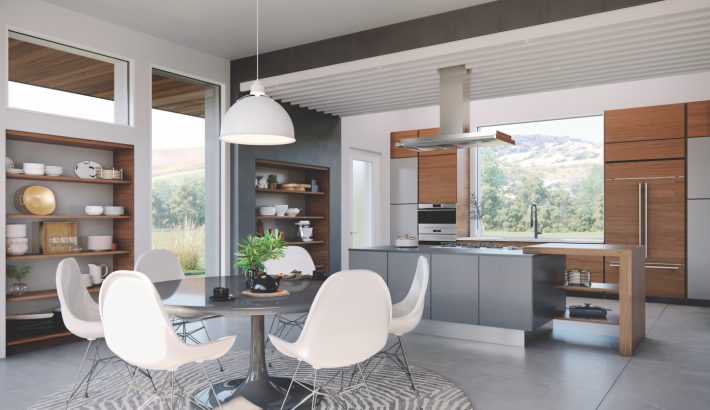Modern vs. Contemporary: Can you Spot the Difference?
Being able to differentiate between these two popular design styles can help customers better articulate their vision.
When embarking on a remodel or a new build project, a customer might say “modern” when they really mean “contemporary”—or vice versa. Though it might seem like an inconsequential difference, clarifying these terms and asking probing questions can result in a much clearer sense of their vision for the project.
Modern and contemporary styles do share common traits, so explaining the difference can be confusing. Your ability to articulate the differences and explore the aesthetic attributes associated with each means you can better anticipate and translate a customer’s vision across all stages of home design, material selection and construction. Here’s a brief tutorial:
Contemporary
The term “contemporary” refers to the architecture of today, of the moment. If that definition sounds broad, it is. Contemporary is a fluid, constantly morphing architectural style. It shouldn’t be surprising to learn a contemporary home could include a mix of aesthetics—including elements of traditional, transitional, and, yes, modern architecture.
This design flexibility reflects varied design preferences. The fact is, not every aspect of contemporary architecture needs to have a purpose or observe a set of aesthetic rules. If a crown molding is desired in the dining room, why not? Contemporary style reflects the times and buyer tastes. Chicago residential architect Scott Rappe, principal of Kuklinski+Rappe Architects, says “… Contemporary means anything that’s being done in the present.”
In general, contemporary architecture today is characterized by:
- Non-symmetrical shapes, mixed materials, open spaces, curves and/or sweeping lines
- Sustainable, eco-friendly, energy efficient
- Abundant natural light
- Reduced indoor/outdoor separation with alfresco kitchens, outdoor rooms with fireplaces, a feeling of spaciousness
- Mixed-use space: a guestroom that doubles as an office, or a craft and homework space combined
- Aspects of the regional character
Modern
Principles of modern design, which flourished in America through the first half of the 20th century and continues to enjoy popularity today, includes clean, straight lines with limited detail. This differs from contemporary design, which uses curves and/or sweeping lines versus the crisper, sharper and very spare lines of modern. Windows and doors encompass broad horizontal spaces and are often designed as a ribbon of glass.
“Modern design is a more honest look at what a building is—load-bearing columns, beams that transfer the weight, and not putting things in for decoration,” said Rebecca Comeaux, AIA, LEED AP, Associate at Lake | Flato Architects in San Antonio, Texas. “It’s still beautiful, but there’s kind of a level of honesty and simplicity in the design.”
Other characteristics:
- Rectangular exteriors with flat roofs and a distinct linear framework
- Clean, straight lines with limited detail—crisp, sharp, very spare
- Open floor plans and large spaces that connect to outdoor living spaces and/or nature
- Changes in elevation (split-level spaces)
- Indoor/outdoor space
- Monochromatic color palette
- Spaces with minimal ornamentation and clutter
Industry Response
Building product manufacturers are responding to the growing interest in modern architectural style by offering residential and commercial builders new ways to express the popular aesthetic in new construction and remodeling.
We at Marvin responded with the launch of our Modern product line of windows and doors from the Marvin Signature Collection.









